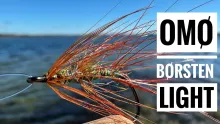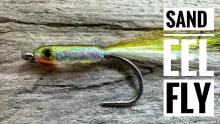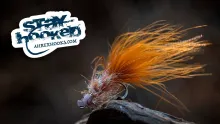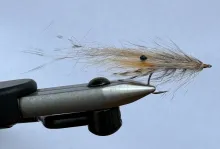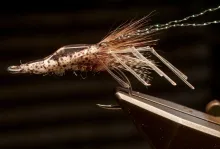This is the first part of a small series dealing with various coastal conditions in the Baltic. We'll look at flies for clear, but turbulent water. Lots of visibility, but also lots of turmoil – and food.
These flies are meant to be fished in waves and swells, but where the water is still clear. Certain coastal areas where rocks and stones dominate, will stay clear for a long time even after the waves start rising and the water starts churning. The turbulence will stir up the food items and throw them around in the water. It will also break the light and affect both hunter and quarry. The aim here is for the flies to be visible but not scary shiny. Bright and colorful is often a key here, but sometimes size is also a key, having a fly that disturbs the water enough to be detected by the hunting fish.
You should certainly not let waves keep you from fishing the Baltic. As long as the water is just slightly clear it makes very good sense to cast your fly. Many locations - especially in the inner Baltic on the Danish island Bornholm and along the Swedish and eastern Baltic coast - will stay clear and free of weed and debris even in pretty large waves, and the broken surface, breaking waves and turbulent water will often get the fish on their fins and close to the coast. The turbulence will also disguise both you and your casts, enabling you to fish and cast unseen. But since you want the fish to see the flies, going large and colorful is sometimes a key to success.
Using a neutral or intermediate line can also be a key. A floating line will have a tendency to ride on the waves and make you loose contact to the fly, while the slowly sinking line cuts into the waves and stays straight - or at least straighter. You can also shorten your leader and maybe go up a thickness or two, which will make casting easier and reduce the risk of a fish breaking off. Sometimes fish will take with great vigor and sometimes you will also have fish a little larger than the average go close to the coast and hunt in the shallows when they are protected by the conditions.
Bloody Butcher
This is my go to fly when the water is clear but turbulent. I like the combination of red, black and silver, an something tells me that the fish do too. I have had great success with this pattern. I tie it as a hair winged streamer or as a zonker depending on what size fly I want. Hair winged in sizes 6 and 4, zonker winged (AKA The Bloody Zonker) on longer hooks in size 4 and 2, which gives a pretty large fly.
I currently prefer tying the fly on my favorite hook, the Kamasan B175, which is a classic Limerick style heavy wire streamer hook that can tolerate saltwater quite well.
Mini Pig
I actually rarely fish the Mini Pig myself, but good and knowledgeable friends of mine have had great success with it. It's colorful and visible, but at the same time not too big and a good imitation of a shrimp – albeit very pink. But fish have something with pink. I don't know what, but it works.
Strange Christmas Tree
Another fly developed particularly for these conditions, and very efficient for choppy water and windy conditions, which haven't totally stirred up the water. Very visible, simple to tie, but still a good imitation of a small fish and something that can tempt a hungry fish.
Almost any Zonker
Almost any large zonker will be welcome on my tippet when water is clear but turbulent. The large fly is visible and tempting, and the fish will often attack with vigor. A Fair Fly, a classic Zonker, a Mango, the above mentioned Bloody Zonker or just any combination of a bright body and a meaty fur strip wing will do the trick the for me – and, oftentimes, for the fish too.
Pavo Real
Pavo Real is a peacock in Spanish, and is the name of this new fly, which uses a Gallo de Leon (AKA Coq de Leon) hackle in combination with a peacock body. The fly is large and gaudy and at the same time dull and fairly discrete. Both the hackle and the herl has a shiny, iridescent nature while still being naturally colored. An almost impossible combo, but never the less possible with these materials. It's tied in the Ullsok, Omoe Brush, Djihad style with three separate hackles.
The finely speckled Gallo de Leon feathers give this fly a look not far from the classic Tippet Grub, but with the traits of a modern coastal fly. The large hackle makes the fly unwilling to break the surface and makes it sink very slowly, so adding some weight in the form of tungsten foil under the body or eyes in the front is an idea if you want it to penetrate the water column better.
Tying instructions
|
|
|
|
|
|
|
|
|
|
|
|
|
|
|
|
|
|
|
|
|
|
|
|
|
|
|
|
|
|
Hand picked for this article
- Log in to post comments














































